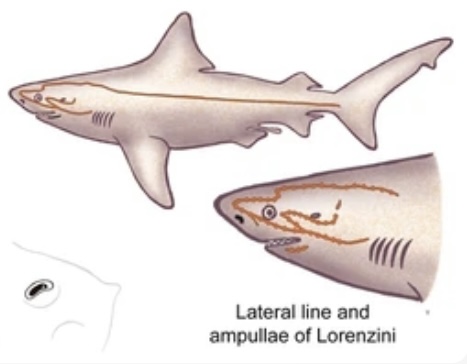INTRODUCTION

The lateral line system is a remarkable sensory adaptation found in most fish species, allowing them to perceive and navigate through their aquatic environments effectively. This sensory system comprises a network of mechanoreceptive organs, called neuromasts, distributed along the fish’s body. Through the lateral line system, fish can detect water movements, vibrations, and changes in pressure, enabling them to detect prey, avoid predators, and maintain coordinated movement within their aquatic habitats. In this article, we will conduct a comparative study of the lateral line systems in fishes, exploring their structures, functions, and adaptations across different species.
STRUCTURE AND ORGANISATION OF THE LATERAL LINE SYSTEM

The lateral line system consists of two main types of neuromasts: superficial and canal neuromasts. Superficial neuromasts are embedded within specialized structures called scales, while canal neuromasts are situated within fluid-filled canals located beneath the fish’s skin.
Superficial neuromasts are found in various arrangements, depending on the fish species. In some species, they are distributed uniformly along the body, while in others, they form clusters or rows. Each neuromast consists of a central hair cell surrounded by support cells. These hair cells possess cilia, or hair-like projections, which are deflected by water movements. The deflection of cilia stimulates the hair cells, initiating electrical signals that are transmitted to the fish’s nervous system.
Canal neuromasts, on the other hand, are housed within fluid-filled canals that run along the fish’s body. These canals contain specialized sensory cells that respond to water displacement caused by nearby objects or movements. The arrangement and number of canals vary among species, with some fish possessing short canals while others have extensive canal systems.
FUNCTIONS AND ADAPTATIONS OF THE LATERAL LINE SYSTEM
The lateral line system serves various crucial functions in fishes, facilitating their survival and ecological interactions. It allows fish to detect water currents and disturbances, enabling them to locate prey, avoid obstacles, and navigate through complex environments.
One notable adaptation of the lateral line system is its ability to detect low-frequency vibrations and pressure changes. This adaptation is particularly useful in detecting the movements of nearby fish, potential prey, and even predators. The lateral line system’s sensitivity to hydrodynamic cues helps fish maintain proper distance from objects and engage in coordinated schooling behavior.
The lateral line system also exhibits adaptive modifications in response to different environmental conditions. For instance, in species living in fast-flowing streams or turbulent waters, the lateral line canals are more numerous and well-developed, enhancing the fish’s ability to detect water movements and navigate effectively in challenging conditions.
In some fish species, the lateral line system extends to the head region, forming a cephalic lateral line system. This adaptation enables fish to detect subtle water movements and vibrations produced by nearby objects, aiding in prey detection and navigation in complex habitats.
COMPARATIVE ANATOMY OF THE LATERAL LINE SYSTEM

The lateral line systems exhibit significant variations across fish species, reflecting adaptations to diverse habitats and lifestyles. Some fish species have a highly developed lateral line system, while others have reduced or even absent lateral line structures.
For example, nocturnal or bottom-dwelling species often possess a well-developed lateral line system, as it plays a vital role in their foraging and navigation in low-light or dark environments. In contrast, fish species inhabiting caves or deep-sea habitats, where light is scarce, may have a reduced or absent lateral line system, relying on other sensory adaptations such as increased sensitivity to chemical cues.
Fish species that live in fast-flowing rivers or turbulent waters often exhibit elongated body shapes and a higher density of neuromasts. These adaptations allow them to sense water movements accurately and maintain stability in challenging hydrodynamic conditions.
In some species, the lateral line system undergoes ontogenetic changes, where the arrangement and distribution of neuromasts differ between juvenile and adult stages. This reflects the adaptive significance of the lateral line system in different life stages and ecological contexts.
CONCLUSION
The comparative study of lateral line systems in fish reveals the remarkable adaptability and functional diversity of this sensory system. The structure, organization, and adaptations of the lateral line system vary among fish species, reflecting their ecological niches and selective pressures.
The lateral line system plays a vital role in fish survival, facilitating prey detection, predator avoidance, and environmental navigation. Its sensitivity to water movements, vibrations, and pressure changes enables fish to perceive and respond to their surroundings effectively.
Further research on the comparative anatomy and physiology of lateral line systems in fish will deepen our understanding of sensory adaptations and their ecological significance. This knowledge can have broader implications for fields such as biomimetics and underwater robotics, inspiring innovative technologies based on nature’s sensory designs.
By unraveling the complexities of the lateral line system in fish, we gain insight into the fascinating mechanisms that enable these remarkable creatures to thrive in their aquatic habitats.
Discover more from ZOOLOGYTALKS
Subscribe to get the latest posts sent to your email.

